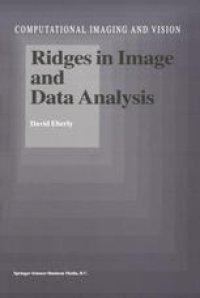
Ebook: Ridges in Image and Data Analysis
Author: David Eberly (auth.)
- Tags: Computer Imaging Vision Pattern Recognition and Graphics, Differential Geometry, Imaging / Radiology, Physical Chemistry, Mechanics
- Series: Computational Imaging and Vision 7
- Year: 1996
- Publisher: Springer Netherlands
- Edition: 1
- Language: English
- pdf
The concept of ridges has appeared numerous times in the image processing liter ature. Sometimes the term is used in an intuitive sense. Other times a concrete definition is provided. In almost all cases the concept is used for very specific ap plications. When analyzing images or data sets, it is very natural for a scientist to measure critical behavior by considering maxima or minima of the data. These critical points are relatively easy to compute. Numerical packages always provide support for root finding or optimization, whether it be through bisection, Newton's method, conjugate gradient method, or other standard methods. It has not been natural for scientists to consider critical behavior in a higher-order sense. The con cept of ridge as a manifold of critical points is a natural extension of the concept of local maximum as an isolated critical point. However, almost no attention has been given to formalizing the concept. There is a need for a formal development. There is a need for understanding the computation issues that arise in the imple mentations. The purpose of this book is to address both needs by providing a formal mathematical foundation and a computational framework for ridges. The intended audience for this book includes anyone interested in exploring the use fulness of ridges in data analysis.
This book provides a thorough development of ridges and their application to image and data analysis. The text is self-contained by including a chapter on the necessary mathematical background, chapters on the formal ridge definitions in any geometric setting, and a chapter on the numerical implementation. An applications chapter covers three separate topics: medical image analysis, molecular modeling, and analysis of fluid flow.
Audience: The book is intended primarily for computer vision and image processing scientists with a background in mathematics and scientific computation. However, ridges provide a general purpose tool for multidimensional data analysis, so the book will be of interest to practitioners in any field which requires the analyzing of data, such as statistics, the physical sciences, or engineering.
This book provides a thorough development of ridges and their application to image and data analysis. The text is self-contained by including a chapter on the necessary mathematical background, chapters on the formal ridge definitions in any geometric setting, and a chapter on the numerical implementation. An applications chapter covers three separate topics: medical image analysis, molecular modeling, and analysis of fluid flow.
Audience: The book is intended primarily for computer vision and image processing scientists with a background in mathematics and scientific computation. However, ridges provide a general purpose tool for multidimensional data analysis, so the book will be of interest to practitioners in any field which requires the analyzing of data, such as statistics, the physical sciences, or engineering.
Content:
Front Matter....Pages i-xi
Introduction....Pages 1-7
Mathematical Preliminaries....Pages 9-38
Ridges in Euclidean Geometry....Pages 39-63
Ridges in Riemannian Geometry....Pages 65-73
Ridges of Functions Defined on Manifolds....Pages 75-95
Applications to Image and Data Analysis....Pages 97-154
Implementation Issues....Pages 155-201
Back Matter....Pages 203-215
This book provides a thorough development of ridges and their application to image and data analysis. The text is self-contained by including a chapter on the necessary mathematical background, chapters on the formal ridge definitions in any geometric setting, and a chapter on the numerical implementation. An applications chapter covers three separate topics: medical image analysis, molecular modeling, and analysis of fluid flow.
Audience: The book is intended primarily for computer vision and image processing scientists with a background in mathematics and scientific computation. However, ridges provide a general purpose tool for multidimensional data analysis, so the book will be of interest to practitioners in any field which requires the analyzing of data, such as statistics, the physical sciences, or engineering.
Content:
Front Matter....Pages i-xi
Introduction....Pages 1-7
Mathematical Preliminaries....Pages 9-38
Ridges in Euclidean Geometry....Pages 39-63
Ridges in Riemannian Geometry....Pages 65-73
Ridges of Functions Defined on Manifolds....Pages 75-95
Applications to Image and Data Analysis....Pages 97-154
Implementation Issues....Pages 155-201
Back Matter....Pages 203-215
....